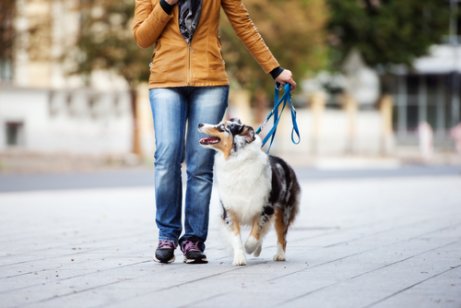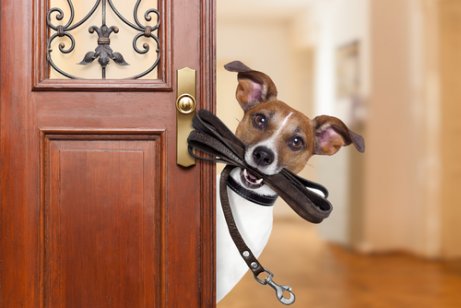Walking Your Dog: tips for successful dog walks

In addition to being a necessary activity for the animal, walking your dog can also give you an opportunity to exercise and be outdoors. In this article, you can go over some tips that can help you have outings that are pleasant and beneficial to you and your dog.
Tips for Walking Your Dog
Taking your pet outside is good for their physical and mental health, but it can also become a nightmare. Tugging, barking, disobedience… This is why it’s a good idea to teach dogs how to go for walks and socialize from a young age. Also, they should know they must pay attention to your orders.
The following recommendations can be very useful, especially if your pet is still a puppy. If your dog is already a few years old, you’ll need to be more patient. Even if it takes time, your dog can continue to learn during their entire lives. Consider the following whenever you walk your dog:
1. Use a leash
It doesn’t matter if you’re just going around the block or if your street isn’t busy. Your dog could become frightened or aggressive due to different factors that can trigger their instincts. For example, a car horn or seeing another dog could cause your dog to run across the street. This could be really dangerous!
You’ll be more able to control your pet’s instincts if they are on a leash. Depending on the size and strength of your dog, the best thing you could use is either a leash and a collar or a harness. Never put the collar or harness too tight on your dog. Two finger-width apart should be enough space between the dog’s neck and the collar.

2. Make your dog stay by your side
This is essential for successful walks with your dog. However, it does take a while to learn. Ever since the first walk, your dog will have to get used to staying with you. You can pick whichever side you want them on, but we recommend keeping the leash in your strongest hand.
To avoid the animal from pulling forward or to the side, make the leash as short as possible without hurting your dog. Pulling on the leash can be an effective technique to prevent the dog from pulling, but we don’t recommend it. You pulling back can cause damage to your dog’s throat or stomach (if they are wearing a harness).
3. Give your dog specific orders
A dog understands their master’s voice and can recognize it among other voices. However, your dog can also become confused when there is a lot of noise or if he is running in the park. That’s why it’s important to teach him the basic rules of going out for walks.
For example: sit, come here, no, stay are words that you should train your dog to understand. You don’t need to give your dog an explanation on why they need to come when you call. Most likely your dog already knows why, but no matter what, they should obey. Specific orders are easier for your pet to understand and follow.

Of course, you shouldn’t forget about your tone of voice. It should be loud and strong, but avoid shouting or repeating the order many times. One or two times at the most should be enough for your dog to respond.
4. Give prizes for good behavior
You should reward your dog when they behave well and correct them when they don’t. This way, walking your dog won’t be a nightmare. Take some treats with you to give as prizes when your dog has good behavior while they are walking with you. The prize will be a good incentive for your dog to behave well.
5. Be calm
Animals can feel nerves, anxiety, or fear in the people around them, especially their owners. Therefore, in order to have success walks with your pet, you should be calm in order to have successful walks with your pet. This way your pet will be calmer, but you’ll also be able to them give clearer directions.
Body language, your tone, and even your breathing rhythm can tell your dog how to behave. If you’re nervous, your dog will be constantly be on the lookout for dangers and won’t be able to respond to your orders as easily.
Finally, when walking your dog – whether a Dalmatian or a Chihuahua – don’t forget to bring a bag to pick up after them. Also, if you notice your pet becoming aggressive with other animals, you can put a muzzle on them.
In addition to being a necessary activity for the animal, walking your dog can also give you an opportunity to exercise and be outdoors. In this article, you can go over some tips that can help you have outings that are pleasant and beneficial to you and your dog.
Tips for Walking Your Dog
Taking your pet outside is good for their physical and mental health, but it can also become a nightmare. Tugging, barking, disobedience… This is why it’s a good idea to teach dogs how to go for walks and socialize from a young age. Also, they should know they must pay attention to your orders.
The following recommendations can be very useful, especially if your pet is still a puppy. If your dog is already a few years old, you’ll need to be more patient. Even if it takes time, your dog can continue to learn during their entire lives. Consider the following whenever you walk your dog:
1. Use a leash
It doesn’t matter if you’re just going around the block or if your street isn’t busy. Your dog could become frightened or aggressive due to different factors that can trigger their instincts. For example, a car horn or seeing another dog could cause your dog to run across the street. This could be really dangerous!
You’ll be more able to control your pet’s instincts if they are on a leash. Depending on the size and strength of your dog, the best thing you could use is either a leash and a collar or a harness. Never put the collar or harness too tight on your dog. Two finger-width apart should be enough space between the dog’s neck and the collar.

2. Make your dog stay by your side
This is essential for successful walks with your dog. However, it does take a while to learn. Ever since the first walk, your dog will have to get used to staying with you. You can pick whichever side you want them on, but we recommend keeping the leash in your strongest hand.
To avoid the animal from pulling forward or to the side, make the leash as short as possible without hurting your dog. Pulling on the leash can be an effective technique to prevent the dog from pulling, but we don’t recommend it. You pulling back can cause damage to your dog’s throat or stomach (if they are wearing a harness).
3. Give your dog specific orders
A dog understands their master’s voice and can recognize it among other voices. However, your dog can also become confused when there is a lot of noise or if he is running in the park. That’s why it’s important to teach him the basic rules of going out for walks.
For example: sit, come here, no, stay are words that you should train your dog to understand. You don’t need to give your dog an explanation on why they need to come when you call. Most likely your dog already knows why, but no matter what, they should obey. Specific orders are easier for your pet to understand and follow.

Of course, you shouldn’t forget about your tone of voice. It should be loud and strong, but avoid shouting or repeating the order many times. One or two times at the most should be enough for your dog to respond.
4. Give prizes for good behavior
You should reward your dog when they behave well and correct them when they don’t. This way, walking your dog won’t be a nightmare. Take some treats with you to give as prizes when your dog has good behavior while they are walking with you. The prize will be a good incentive for your dog to behave well.
5. Be calm
Animals can feel nerves, anxiety, or fear in the people around them, especially their owners. Therefore, in order to have success walks with your pet, you should be calm in order to have successful walks with your pet. This way your pet will be calmer, but you’ll also be able to them give clearer directions.
Body language, your tone, and even your breathing rhythm can tell your dog how to behave. If you’re nervous, your dog will be constantly be on the lookout for dangers and won’t be able to respond to your orders as easily.
Finally, when walking your dog – whether a Dalmatian or a Chihuahua – don’t forget to bring a bag to pick up after them. Also, if you notice your pet becoming aggressive with other animals, you can put a muzzle on them.
This text is provided for informational purposes only and does not replace consultation with a professional. If in doubt, consult your specialist.








